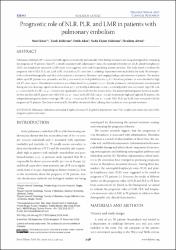| dc.contributor.author | Köse, Nuri | |
| dc.contributor.author | Yıldırım, Tarık | |
| dc.contributor.author | Akın, Fatih | |
| dc.contributor.author | Yıldırım, Seda Elçim | |
| dc.contributor.author | Altun, İbrahim | |
| dc.date.accessioned | 2020-11-20T14:40:09Z | |
| dc.date.available | 2020-11-20T14:40:09Z | |
| dc.date.issued | 2020 | |
| dc.identifier.issn | 1512-8601 | |
| dc.identifier.issn | 1840-4812 | |
| dc.identifier.uri | https://doi.org/10.17305/bjbms.2019.4445 | |
| dc.identifier.uri | https://hdl.handle.net/20.500.12809/676 | |
| dc.description | WOS: 000530872100011 | en_US |
| dc.description | PubMed ID: 31724521 | en_US |
| dc.description.abstract | Pulmonary embolism (PE) is associated with significant morbidity and mortality. New biological markers are being investigated for estimating the prognosis of PE patients. Since PE is closely associated with inflammatory status, the neutrophil-lymphocyte (NLR), platelet-lymphocyte (PLR), and lymphocyte-monocyte (LMR) ratios were suggested to be useful in predicting patient outcomes. This study aimed to evaluate the prognostic role of NLR, PLR, and LMR in PE. A total of 103 PE cases from a cardiology department were included in the study. We retrospectively evaluated demographic and dinical characteristics, treatments, laboratory and imaging findings, and outcomes of patients. The median follow-up of PE patients was 39 months, and the 5-year overall survival probability was 73.8%. Out of 103 patients, 20 were dassified as high risk PE cases (19.4%). Thrombolytic treatment was administered to 23 patients (22.3%). Systolic pulmonary arterial pressure was measured during one year, showing a significant decrease from 51.7 +/- 15.7 mmHg at admission to 26.6 +/- 4.0 mmHg at first year assessment. Age (OR:1.06, p < 0.00.1) and NLR (OR: 1.52,p < 0.0019) were significantly associated with the disease status. The independent prognostic factors in moderate-low and low risk PE groups were NLR (HR: 1.17,p = 0.033) and LMR (FIR: 1.58,p = 0.046). In moderate-high and high risk PE patients, the independent prognostic factors were age (HR: 1.07, p = 0.014) and PLR (HR: 1.01, p = 0.046). NLR, PLR, and LMR were associated with the prognosis of PE patients. The clinical severity of PE should be considered when utilizing these markers to assess patient outcomes. | en_US |
| dc.item-language.iso | eng | en_US |
| dc.publisher | Assoc Basic Medical Sci Federation Bosnia & Herzegovina Sarajevo | en_US |
| dc.item-rights | info:eu-repo/semantics/openAccess | en_US |
| dc.subject | Pulmonary Embolism | en_US |
| dc.subject | Neutrophil-Lymphocyte Ratio | en_US |
| dc.subject | NLR | en_US |
| dc.subject | Platelet-Lymphocyte Ratio | en_US |
| dc.subject | PLR | en_US |
| dc.subject | Lymphocyte-Monocyte Ratio | en_US |
| dc.subject | LMR | en_US |
| dc.subject | Prognosis | en_US |
| dc.subject | Patient Outcomes | en_US |
| dc.title | Prognostic role of NLR, PLR, and LMR in patients with pulmonary embolism | en_US |
| dc.item-type | article | en_US |
| dc.contributor.department | MÜ, Tıp Fakültesi, Dahili Tıp Bilimleri Bölümü | en_US |
| dc.contributor.institutionauthor | Akın, Fatih | |
| dc.contributor.institutionauthor | Altun, İbrahim | |
| dc.identifier.doi | 10.17305/bjbms.2019.4445 | |
| dc.identifier.volume | 20 | en_US |
| dc.identifier.issue | 2 | en_US |
| dc.identifier.startpage | 248 | en_US |
| dc.identifier.endpage | 253 | en_US |
| dc.relation.journal | Bosnian Journal of Basic Medical Sciences | en_US |
| dc.relation.publicationcategory | Makale - Uluslararası Hakemli Dergi - Kurum Öğretim Elemanı | en_US |


















